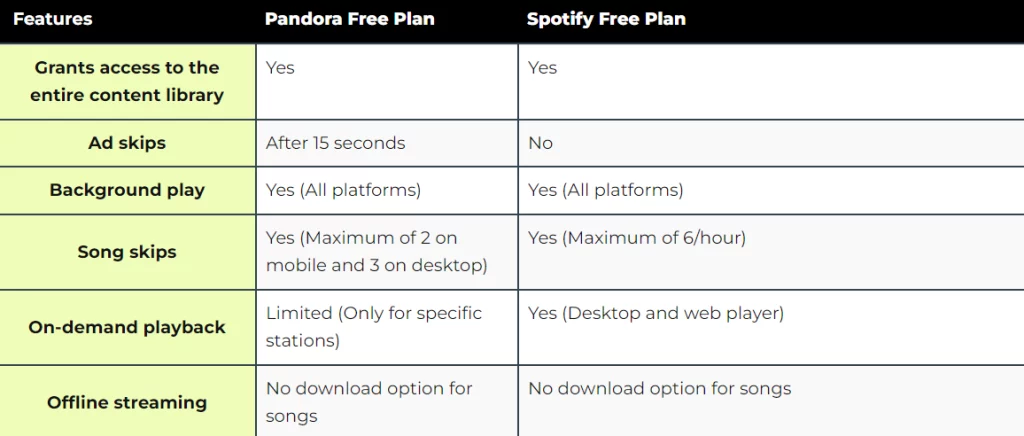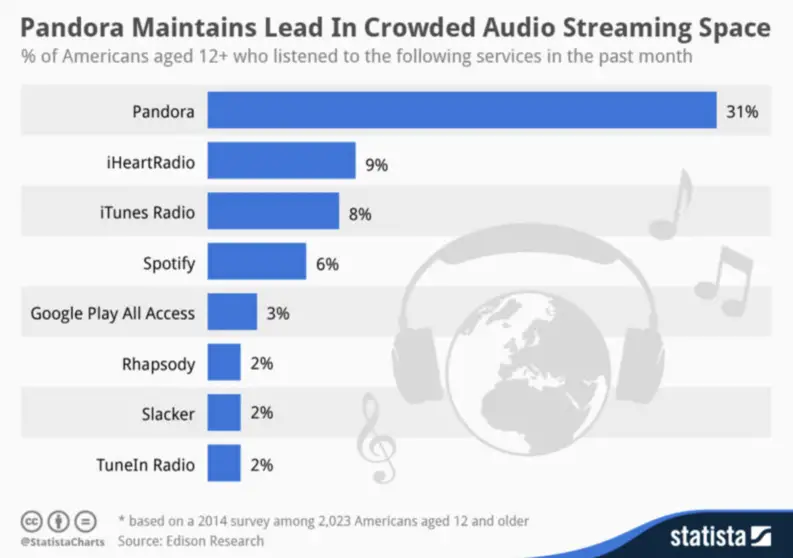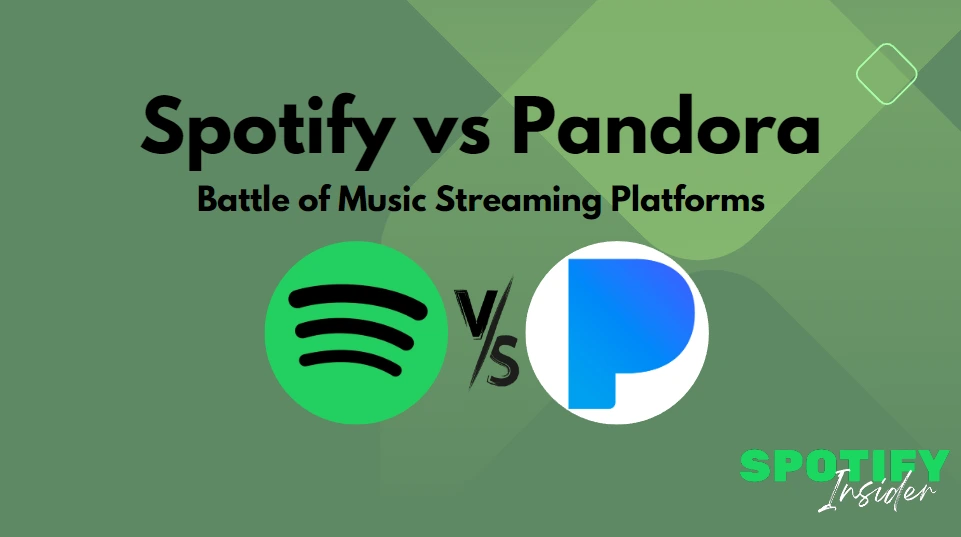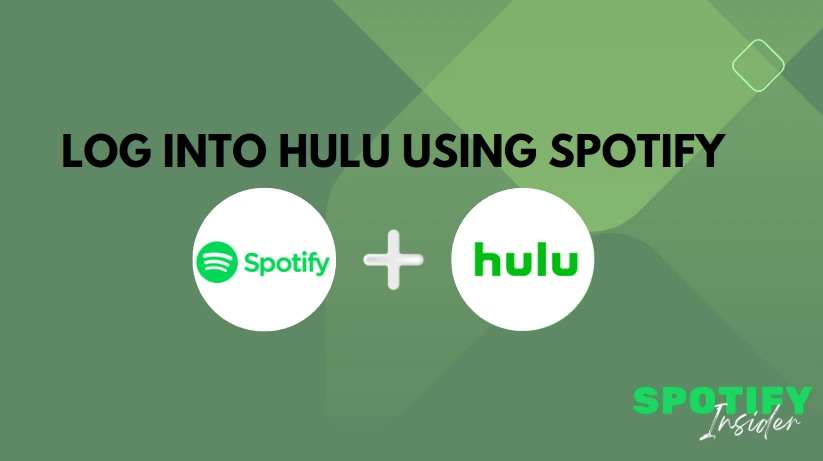Music streaming services have transformed the way we enjoy music, and among the top picks are Spotify and Pandora. These platforms boast extensive music libraries but differ in their offerings. In this article, we’ll delve into the features, strengths, and weaknesses of Spotify vs Pandora. Stay tuned to find out which service suits you best!
Overview of Spotify and Pandora
Spotify and Pandora are big players in the music streaming world, changing how we enjoy music. While they share some similarities, they also have unique features that set them apart.
Spotify lets users search for music by genre, artist, or album with ease. Its search tool is smart, even fixing spelling mistakes. Plus, it offers personalized playlists based on your listening habits, thanks to its clever technology.
Pandora takes a different approach, focusing more on radio-style playlists based on user feedback. Its Music Genome Project is special, matching songs based on their musical traits, helping you discover new music.
Both platforms offer free and paid options. Spotify’s paid version gives you ad-free listening, better audio quality, and offline downloads. These perks are handy for uninterrupted listening and high-quality sound, especially for music lovers.
In the Spotify vs Pandora debate, both have something to offer. Whether you prefer curated playlists or radio-style recommendations, they make music listening easy and enjoyable.
| Features | Pandora | Spotify |
|---|---|---|
| About | Pandora helps discover similar music. | Spotify lets pick & play favorites. |
| Price | Pandora One: $4.99/mo. Free with ads. | Free version with ads. Premium at $9.99/mo. |
| Can pick songs? | No. | Yes. |
| Ads | Yes, on free version. | Yes, on free version. |
| Library Size | About 50 million songs. | Around 70 million songs. |
| Skipping Songs | Limited skips, 6/hr. | Unlimited skips. |
| Custom Playlist | No. | Yes. |
| Can download music? | No. | Yes, for Premium members. |
| Radio | Music-recommendation radio. | Traditional-style radio. |
| Availability | U.S., Australia, New Zealand. | Many countries & territories. |
| Mobile App | Yes. | Yes. |
| Web App | Yes. | Yes. |
| Desktop App | For Pandora One members. | Yes. |
| Parental Controls | Yes. | No. |
| Audio Quality | 64kbps (free), 192kbps (Pandora One). | 160kbps (free), 320kbps (Premium). |
| Website | pandora.com | spotify.com |
Free vs Paid Subscriptions
When it comes to free vs paid subscriptions, both Pandora and Spotify have their own sets of features and limitations.
For free users, both platforms offer music streaming with occasional interruptions from ads. Pandora’s free tier includes timeouts to conserve royalties and limits on skips, while Spotify’s free tier boasts higher audio quality but still includes ads.
Upgrading to a paid subscription unlocks a world of benefits. Pandora One eliminates ads, offers higher audio quality, and allows for longer listening sessions without timeouts. Meanwhile, Spotify Premium offers ad-free listening, offline downloads, and even higher audio quality, along with additional features like Spotify Connect for hardware integration.
Ultimately, choosing between the two depends on your preferences and needs. If you’re looking for an ad-free experience with enhanced audio quality, both Pandora One and Spotify Premium offer great options to enhance your music streaming experience.

Exploring the Advantages and Drawbacks of Spotify and Pandora
When it comes to streaming music, Spotify and Pandora are among the top choices for music lovers. They both offer access to millions of songs, but each has its own set of features and pricing. Let’s take a closer look at the pros and cons of Spotify and Pandora.
Spotify
One of Spotify’s greatest strengths is its extensive music library, boasting over 70 million songs. This vast collection allows users to easily find their favorite tunes and discover new music. Additionally, Spotify offers a range of features that enhance the listening experience.
Spotify stands out for its ability to search, select, and play specific songs, as well as create and share playlists. This level of customization lets users tailor their music journey and share their favorite tracks with others. Moreover, Spotify’s algorithm delivers personalized recommendations based on a user’s listening habits, enhancing music discovery.
Another advantage of Spotify is its compatibility with various devices, including smartphones, tablets, computers, and smart speakers. This versatility ensures users can enjoy their playlists wherever they go.
However, Spotify’s free version includes ads, limited track skips, and lower audio quality. To unlock ad-free listening and other premium features, users must upgrade to Spotify Premium for $9.99 per month.
Pandora
Pandora takes a different approach by focusing on personalized radio stations tailored to a user’s preferences. Users can create stations based on artists, songs, or genres, and Pandora will curate similar tracks.
One of Pandora’s strengths is its free version, which offers unlimited song skips and ad-supported stations. This means users can skip songs without restrictions and enjoy music without paying a subscription fee. Additionally, Pandora offers unique features that set it apart.
However, Pandora lacks the ability to create and share playlists or select specific tracks for streaming. Its music library is also not as extensive as Spotify’s, limiting the availability of certain songs.
In summary, both Spotify and Pandora offer unique features and benefits. While Spotify excels in customization and music discovery, Pandora provides a hassle-free listening experience with its personalized radio stations. Ultimately, the choice between the two depends on individual preferences and priorities.
User Interface and Experience
When it comes to music streaming, the way users interact with the platform plays a crucial role. Spotify has garnered a large following, thanks to its user-friendly interface. Right from the start, users encounter a neat layout that makes navigating through features a breeze.
A standout feature of Spotify is its personalized playlists. Using a sophisticated algorithm, the platform analyzes user preferences to create playlists tailored to their taste. This not only saves time but also enhances music discovery.
Another factor that distinguishes Spotify is its vibrant online community. With millions of users contributing daily, there’s no shortage of user-generated content. From playlists to podcasts and social media-style features, users can connect with their favorite artists and influencers.
In contrast, Pandora’s interface can be less intuitive. Its radio-style algorithm takes time to analyze user preferences, leading to delays in suggesting new songs. Moreover, the absence of a search feature can frustrate users looking for specific tracks or artists.
Overall, Spotify offers a seamless user experience with personalized playlists and a thriving community. It’s no surprise that Spotify remains the preferred choice for many music enthusiasts.

Exploring Additional Features
When comparing Spotify and Pandora, the size of their music libraries and the availability of social and parental control features are crucial aspects to consider.
Pandora, with its extensive library of over a million songs, excels in discovering obscure independent artists, fostering a culture of music exploration. Moreover, its robust parental control options provide peace of mind for parents concerned about explicit content.
In contrast, Spotify boasts a larger catalogue of about 20 million songs, thanks to its aggressive deals with major and independent labels. While lacking in parental controls, Spotify shines in its versatile sharing capabilities, allowing users to share individual songs, albums, and playlists seamlessly.
Spotify’s dominance extends beyond computers and mobile devices, with widespread support across audio-video receivers, media players, and even modern automobiles. On the other hand, Pandora’s integration into various devices, including HDTVs and digital radio systems in cars, enhances its accessibility in different settings.
In essence, while Pandora excels in music discovery and parental controls, Spotify offers a broader range of music and flexible sharing options, making it a preferred choice for many users seeking a comprehensive music streaming experience.
Availability and Popularity
Pandora holds a strong position in the U.S., boasting a larger user base compared to Spotify. However, when it comes to global reach, Spotify takes the lead, offering its services in numerous countries and territories beyond the U.S., Australia, and New Zealand.
While Pandora’s popularity remains high among Americans, Spotify’s availability in multiple regions has contributed to its widespread recognition worldwide. Despite this, Pandora has maintained its dominance in the U.S., with statistics showing a higher number of active users compared to Spotify.
As of 2014, Pandora reported a significant milestone of 200 million users, with a substantial portion actively engaging with the platform each month. In contrast, Spotify boasted approximately 40 million users, with a notable portion subscribing to its premium service.
Both Pandora and Spotify rely on various revenue streams, including advertising and premium subscriptions, to sustain their operations. However, despite their popularity and user base, both companies operated at a net loss as of 2014.

Conclusion: Overall Assessment
In the battle of Spotify vs Pandora, both streaming services have their strengths and weaknesses, catering to different preferences and needs.
Spotify stands out for its rich features, including exclusive content and robust customization options. With its intuitive interface and personalized playlists, Spotify offers a comprehensive music streaming experience tailored to individual tastes. The platform’s emphasis on user experience and quality content makes it a top choice for music enthusiasts seeking variety and control over their listening experience.
On the other hand, Pandora excels in its personalized radio-style streaming and unobtrusive ads. The platform’s focus on creating customized stations based on user preferences provides a seamless listening experience, making it a favorite among those who enjoy discovering new music effortlessly.
Ultimately, the choice between Spotify and Pandora boils down to personal preferences. While Spotify offers a broader range of features and customization options, Pandora’s simplicity and personalized radio stations appeal to users looking for a more laid-back listening experience. Whether you prioritize exclusive content and customization or personalized radio-style streaming, both Spotify and Pandora offer unique benefits that cater to diverse musical tastes.



